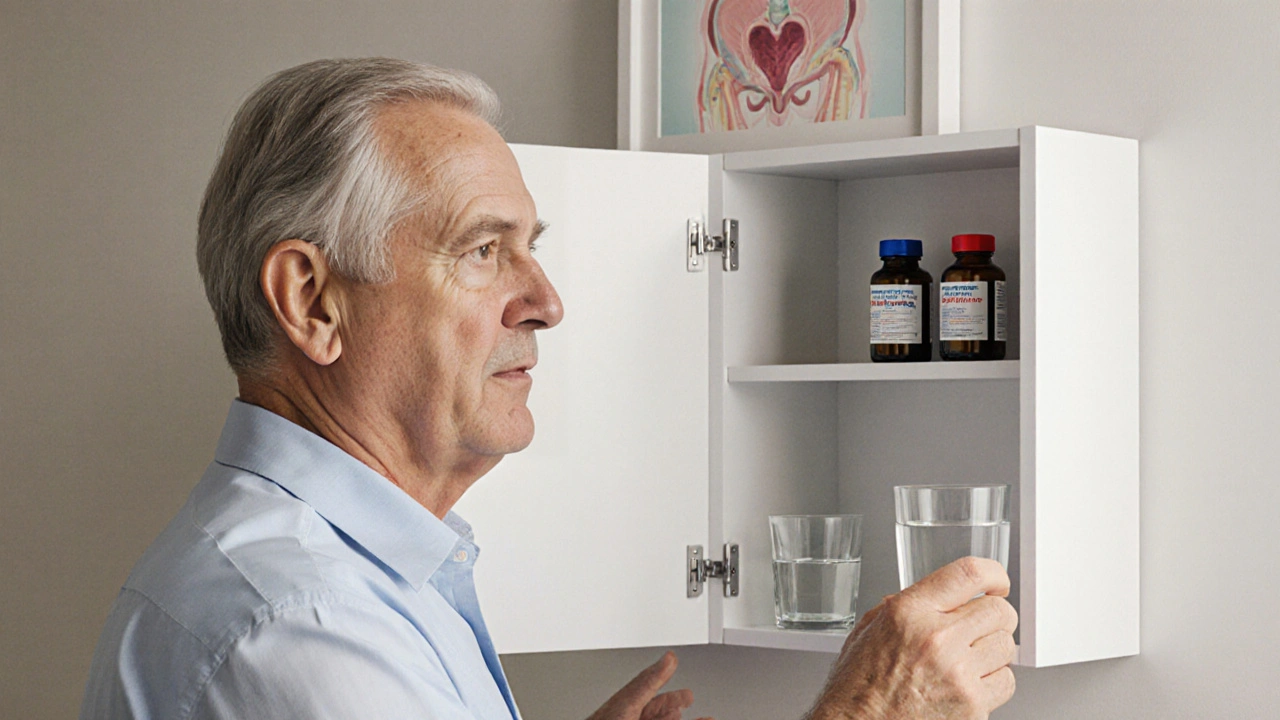How Benign Prostatic Hyperplasia Affects Erectile Dysfunction - Causes & Solutions
 Sep, 28 2025
Sep, 28 2025
When men start noticing frequent trips to the bathroom or a dip in bedroom confidence, they often think the two issues are unrelated. In reality, Benign Prostatic Hyperplasia is a non‑cancerous enlargement of the prostate that can trigger urinary symptoms and, indirectly, erectile problems. Understanding how these conditions intersect helps you spot warning signs early, choose the right treatment, and keep both bladder and bedroom health in check.
Quick Take
- Both BPH and erectile dysfunction (ED) share age‑related hormonal changes and vascular issues.
- Poor urinary flow, nighttime urination, and pelvic floor tension can lower sexual confidence.
- Medications for BPH (alpha blockers, 5‑α‑reductase inhibitors) may improve or worsen erections.
- Lifestyle tweaks-weight control, regular exercise, limited alcohol-benefit both conditions.
- Combined therapy (e.g., PDE5 inhibitors with BPH meds) often restores normal function for many men.
What Is Benign Prostatic Hyperplasia?
Benign Prostatic Hyperplasia is a common condition in men over 50 where the prostate gland slowly grows, compressing the urethra and making it harder to empty the bladder. Typical symptoms include a weak stream, urgency, nocturia (waking up at night to pee), and a constant feeling of incomplete emptying. The condition is not cancerous, but its impact on daily life can be significant, especially when urinary discomfort spills over into sexual performance.
What Is Erectile Dysfunction?
Erectile Dysfunction is the persistent inability to achieve or maintain an erection sufficient for satisfactory sexual activity. While occasional lapses are normal, chronic ED often points to underlying health issues such as vascular disease, hormonal imbalance, or psychological stress.
Why the Two Conditions Overlap
The link between BPH and ED isn’t a coincidence; several physiological pathways intersect.
- Vascular Health: Both a healthy erection and smooth urine flow depend on good blood circulation. Narrowed arteries reduce blood supply to the penis and the prostate, creating a double hit.
- Testosterone levels naturally decline with age. Low testosterone can worsen prostate enlargement and lower libido, feeding into ED.
- Pelvic floor muscles, the same group that helps control urination, also support penile rigidity. Chronic tension from trying to stop leaks can fatigue these muscles, weakening erections.
- Psychological stress from nighttime bathroom trips and daytime urgency often erodes confidence, a key component of sexual performance.
Medical Treatments: How They Interact
Doctors usually target BPH and ED with separate drug families, but the interactions matter.
| Medication Category | Primary Use | Effect on Erectile Function |
|---|---|---|
| Alpha Blockers | Relax prostate smooth muscle to improve urine flow | Often neutral; some men report modest improvement because of better pelvic blood flow |
| 5‑α‑Reductase Inhibitors | Shrink prostate by blocking conversion of testosterone to DHT | May slightly reduce libido initially; long‑term benefits to sexual health by lowering DHT‑related vascular strain |
| PDE5 Inhibitors | Treat ED by enhancing nitric oxide‑mediated blood flow | Can also improve lower urinary tract symptoms, offering a two‑in‑one solution for many men |
When a doctor prescribes an Alpha Blocker like tamsulosin and the patient later adds a PDE5 Inhibitor such as sildenafil, the combined effect often smooths both urination and erections without dangerous interactions. However, mixing certain BPH drugs with nitrate heart medication can trigger severe blood pressure drops, so always disclose your full medication list.

Lifestyle Tweaks That Help Both
Beyond pills, everyday habits play a huge role.
- Weight Management: Excess belly fat contributes to insulin resistance, which damages blood vessels feeding the penis and prostate.
- Regular Exercise: Aerobic activity boosts nitric oxide production, improves circulation, and helps regulate hormone levels.
- Limit Alcohol & Caffeine: Both can irritate the bladder and temporarily hinder erectile response.
- Pelvic Floor Physical Therapy: Targeted exercises strengthen the muscles that control urination and support erection rigidity.
- Sleep Hygiene: Quality rest lowers cortisol, a stress hormone that can worsen both urinary urgency and erectile failure.
When to See a Doctor
If you notice any of these patterns, it’s time to schedule a check‑up:
- Frequent nighttime trips to the bathroom (more than twice per night). \n
- Weak or interrupted urine stream that’s getting worse.
- Consistent difficulty achieving an erection, even when aroused.
- Feelings of anxiety or embarrassment around sexual activity.
A urologist can run a digital rectal exam, PSA test, and ultrasound to gauge prostate size, while a specialist in sexual health can assess vascular function and hormone levels. Early detection often means simpler, less invasive treatment.
Putting It All Together: A Practical Action Plan
Here’s a step‑by‑step roadmap you can follow the next time you notice urinary or sexual changes.
- Track Symptoms: Keep a simple diary of bathroom visits, flow quality, and erection attempts for two weeks.
- Check Medications: Review any current drugs (including over‑the‑counter supplements) for possible side‑effects on sexual function.
- Consult a Professional: Bring your diary to a urologist; they may order a uroflowmetry test to quantify urine speed.
- Discuss Integrated Therapy: Ask whether a PDE5 inhibitor could double‑address both BPH symptoms and ED.
- Adopt Lifestyle Changes: Start with 30 minutes of brisk walking five days a week and a pelvic floor routine (quick Kegels: three sets of ten, holding each contraction for three seconds).
- Re‑evaluate After 8‑12 Weeks: Note any improvement in urinary frequency, nighttime awakenings, and erection quality. Adjust meds or therapy with your doctor as needed.
Following this plan often restores a smoother flow-both literally and figuratively-without resorting to invasive surgery.
Key Takeaways
The relationship between benign prostatic hyperplasia and erectile dysfunction is a two‑way street. Hormonal shifts, blood‑vessel health, and pelvic muscle tension create a feedback loop that can trap men in a cycle of discomfort and confidence loss. By treating the prostate, supporting vascular health, and making smart lifestyle choices, you can break the cycle and enjoy better bladder control and bedroom performance.
Frequently Asked Questions
Can BPH medication cause erectile dysfunction?
Most BPH drugs, like alpha blockers, are neutral or even modestly beneficial for erections. However, some men report temporary libido dips with 5‑α‑reductase inhibitors, especially during the first few weeks. Your doctor can adjust the dose or add a PDE5 inhibitor if needed.
Is nighttime urination a sign of prostate cancer?
No. Frequent nighttime trips are far more common with BPH, urinary infections, or an overactive bladder. Prostate cancer usually presents without urinary symptoms in early stages. Still, any sudden change should trigger a medical review.
Do natural supplements help with both BPH and ED?
Some herbs-like saw palmetto and pygeum-may modestly ease BPH symptoms, while L‑arginine can boost nitric oxide for erections. Evidence varies, so use them as adjuncts, not replacements, and discuss any supplement with your doctor.
Can pelvic floor exercises improve erectile function?
Yes. Strengthening the pelvic floor improves blood flow and muscle control around both the urethra and penis, often reducing urinary urgency and enhancing erection rigidity.
What age does BPH typically start?
Prostate growth can begin in the late 30s, but noticeable symptoms usually appear after age 50. Regular check‑ups become especially important after that milestone.
Sakthi s
September 29, 2025 AT 01:25This is such a clear, practical breakdown-thank you for putting this together. So many men suffer in silence, and this gives real hope.
Robert Altmannshofer
September 29, 2025 AT 20:58Man, I wish I’d read this five years ago. I was convinced my ED was all in my head-turns out my prostate was doing a silent takeover. Started walking daily, cut back on beer, and asked my doc about tamsulosin + sildenafil. Didn’t think it’d work together, but now I’m sleeping through the night AND my wife says I’m back. No magic pill, just smart combos and showing up for yourself.
Julia Jakob
October 1, 2025 AT 03:59They say it’s about blood flow but honestly? It’s about control. You lose control of your bladder, you start doubting you can control anything else-especially your own body. I used to think ED was weakness, but now I see it’s just your body screaming that the system’s overloaded. Stop treating symptoms. Start treating the whole damn machine.
Ben Wood
October 3, 2025 AT 02:33Actually, I’ve got to push back on this a bit-this whole "BPH causes ED" narrative is oversimplified. You’re ignoring the fact that most men with BPH don’t have ED, and most men with ED don’t have BPH. The correlation is statistical noise dressed up as causation. Also, "pelvic floor tension"? That’s not even a real medical term-sounds like a wellness influencer’s buzzword. You’re conflating correlation with mechanism, and it’s misleading.
Abhi Yadav
October 4, 2025 AT 06:12Bro... we’re all just meat machines with plumbing issues. The prostate? It’s just the universe’s way of reminding us we’re not immortal. But hey, if you can still laugh at yourself while peeing in the dark, you’re already winning. I take saw palmetto, do 10 Kegels before bed, and drink water like it’s my job. Life’s short. Don’t let your bladder steal your dignity. 🤝
Kathleen Koopman
October 5, 2025 AT 13:20Thank you for this!! 🙏 I just started PDE5 inhibitors and was terrified they’d make my BPH worse-this explains everything. I’ve been tracking my symptoms like you said and already see a difference in morning flow! Also, walking 30 mins a day feels so much better than I thought it would. Not a cure, but a reset. 💪
Nancy M
October 7, 2025 AT 06:43As someone who grew up in a household where men never spoke about these issues, I’m profoundly grateful for this post. It’s not just medical-it’s cultural. We teach boys to be stoic, to ignore discomfort, to equate vulnerability with weakness. This article doesn’t just inform-it liberates. Thank you for speaking plainly, with dignity, and without shame.
gladys morante
October 7, 2025 AT 14:22I’m not saying this is a conspiracy, but… why is every single article about BPH and ED funded by Big Pharma? Who benefits if men start doing pelvic floor exercises instead of buying pills? I’ve seen ads for these drugs on YouTube before I even knew what BPH was. Coincidence? I think not.
Precious Angel
October 8, 2025 AT 15:13Let’s be real-this whole "natural remedies" and "walk more" advice is just a distraction. The truth? Your prostate doesn’t grow because of age-it grows because your body is being poisoned by environmental toxins, glyphosate in your food, endocrine disruptors in your shampoo, and the silent radiation from your phone. Nobody talks about this because the FDA is in bed with the pharmaceutical industry. You think your doctor cares about your dignity? He’s paid to sell you a script. Wake up. The system is designed to keep you dependent. Your body is trying to heal itself-you’re just being medicated into submission.
Melania Dellavega
October 10, 2025 AT 06:24I’ve watched my father go through this, and I’ve seen how silence breaks men. Not the physical symptoms-the shame does it. This post doesn’t just give advice-it gives permission. Permission to ask for help. Permission to say, "I’m struggling." Permission to be human. That’s the real treatment. The rest? Just tools. You can have all the pills and walks in the world, but if you don’t feel safe talking about it, nothing changes. Thank you for making this feel less lonely.
Rachel Nimmons
October 11, 2025 AT 01:07Did you know that some urologists are now using AI to predict which patients will develop ED based on urine flow patterns? I read a leaked document that said they’re already tracking this data to sell targeted ads. They’re not just treating you-they’re profiling you. Be careful what you share.
Robert Altmannshofer
October 11, 2025 AT 21:31That’s wild, Rachel-I didn’t even think about data tracking. But honestly, if the doc’s using AI to help me, I’m all for it. I’d rather they catch it early than wait till I’m peeing in a cup every week. Still… you’re right to be suspicious. Maybe we should ask for a copy of our own data.